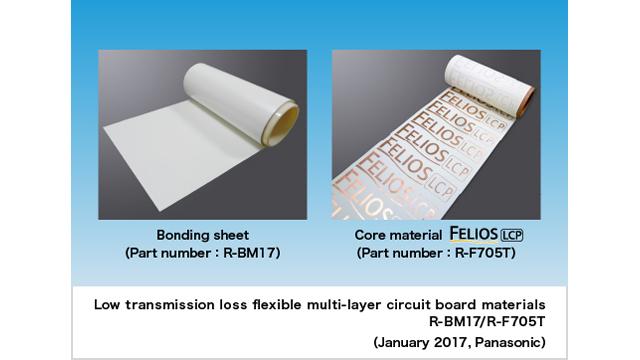
Nov 18, 2025
- Products & Solutions
- Stories
- Operating Company
Jan 17, 2017
Products & Solutions / Press Releases

Panasonic's "low transmission loss flexible multi-layer circuit board materials" is designed for high-speed large-volume data transmission and is used in thinner mobile devices.
Osaka, Japan - Panasonic Corporation announced today that it has commercialized its Low Transmission Loss[1] Flexible Multi-layer Circuit Board Materials, suitable for high-speed large-volume data transmission and thinner designs of mobile devices, including smartphones and tablet computers. The company will launch its mass production in January 2017. The combination of a liquid-crystal polymer (LCP) core material[2] and a bonding sheet material that can be laminated at a low temperature and stored at room temperature will considerably ease the manufacture of high-frequency flexible multi-layer circuit boards.
Existing coaxial cables[3] used for large-volume transmission are thick, so they present an obstacle to making mobile devices thinner. Low transmission loss flexible multi-layer circuit boards are of increasing potential as a solution that achieves both large-volume data transmission and a thin design, but they face many restrictions in how they should be handled, due to the characteristics of the materials they incorporate, so they require special facilities for manufacturing. Using its unique resin design technologies, Panasonic has developed a bonding sheet that can be laminated at a low temperature of less than 200 °C and stored at room temperature. This eliminates the need for special facilities for high-temperature lamination and refrigerated storage for bonding sheets. The company has also achieved high adhesiveness of LCP and low profile copper foil for the LCP core material by using its unique laminating techniques. Although existing flexible core materials using polyimide and so on are usable for only low-speed transmission, the new material, due to its low transmission loss property can also be used for high-speed transmission of large-volume data.
Circuit boards for high-frequency antenna modules, high-speed cables, etc.
There is a growing need for faster transmission of signals due to the increasing volume of data demanded by the ever-higher resolutions of mobile device cameras and display screens. As a result, low transmission loss flexible multi-layer circuit boards that enable large-volume, high-speed transmission are of increasing interest as a replacement for currently-used coaxial cables; and low transmission loss, meaning that only a small amount of the signal is lost during transmission, is desired for the circuit board material. Panasonic has commercialized a low transmission loss core material and bonding sheet by applying its unique resin design technologies. It supports standards including USB 3.1 Gen 2 (10 Gbps) and will enable increased speed of large-volume data transmission in mobile devices.
A coaxial cable is composed of one signal line in a cable and is capable of large-volume data transmission, but its downside is its thickness. A low transmission loss flexible multi-layer circuit board has several signal lines within it, so large-volume data transmission and a thinner design can be achieved simultaneously. Adopting this material allows flexible multi-layer circuit boards, in a 0.2 mm-thick, 3-layer structure that can carry several signal lines, to replace coaxial cables.
Previous bonding sheet, which forms the low transmission loss flexible multi-layer circuit boards with core material, had to be laminated at a high temperature or stored refrigerated. It was also difficult to handle, due to its material characteristics, and required special facilities that placed a burden on manufacturers. Using its unique resin design technologies, Panasonic has developed a bonding sheet that can be laminated at a low temperature of 200 °C or less, and stored at room temperature, making it far easier to handle the material during production. By providing this sheet and the low-transmission loss core material, the company will considerably facilitate the production of flexible multi-layer circuit boards.

Panasonic Corporation is a worldwide leader in the development of diverse electronics technologies and solutions for customers in the consumer electronics, housing, automotive, enterprise solutions and device industries. Since its founding in 1918, the company has expanded globally and now operates 474 subsidiaries and 94 associated companies worldwide, recording consolidated net sales of 7.553 trillion yen for the year ended March 31, 2016. Committed to pursuing new value through innovation across divisional lines, the company uses its technologies to create a better life and a better world for its customers. To learn more about Panasonic: http://www.panasonic.com/global.
Panasonic Corporation
Tel: +81-(0)3-3574-5664 Fax: +81-(0)3-3574-5699
The content in this website is accurate at the time of publication but may be subject to change without notice.
Please note therefore that these documents may not always contain the most up-to-date information.
Please note that German, Spanish and Chinese versions are machine translations, so the quality and accuracy may vary.